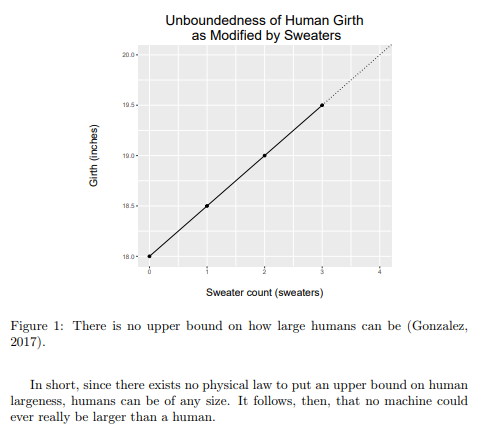Cross-posting the best April Fool's Day joke in the history of effective altruism.
Abstract
In recent years, a number of prominent computer scientists, along with academics in fields such as philosophy and physics, have lent credence to the notion that machines may one day become as large as humans. Many have further argued that machines could even come to exceed human size by a significant margin. However, there are at least seven distinct arguments that preclude this outcome. We show that it is not only implausible that machines will ever exceed human size, but in fact impossible.
Selected Excerpts
Before each person is a full-sized adult, they are first an invisibly small cell. It is perhaps no surprise, then, that human largeness has for thousands of years fascinated many of our greatest thinkers. While some have sought to understand the nature and origins of largeness, others have anxiously inquired: Could there ever be something larger than a human?
Scientists are at the point of being able to identify traits that correlate with largeness—certain genetic markers, for instance—but they have nothing like a complete theory of the causal pathways that explain these correlations. All attempts to construct such a theory have been stymied by the irreducible complexity of the human body, which contains tens of thousands of distinct proteins (Wilhem, 2014). It seems inevitable that, for this same reason, all future attempts will fail as well. Since we cannot comprehend the processes responsible for human largeness, it follows that we will never be able to produce machines that surpass this largeness.

Suppose one were to concede that machines could become as large as humans, in some sense related to physical extension (although this is of course impossible).
Even if this were so, there would still remain a second, more meaningful sense of the word “large” that would not apply to these machines.
This second kind of largeness is the one evoked whenever someone is described as “larger than life” or “living large” (Tom, 2004). Largeness of this sort is a non-physical (i.e. non-natural) property, separate from the mundane physical property that “largeness” most often denotes.
To build a large machine, then, in the meaningful sense, we would first need to solve the “hard problem” of determining what this non-physical property is and how it arises. However, it is not at all clear that the problem is soluble, since the traditional methods of science seem equipped only to deal with questions that concern the physical world (Hall, 2010). Furthermore, the notion of a machine “living large” strikes one as intuitively implausible (perhaps even absurd).
Therefore, machines will never truly be large.
